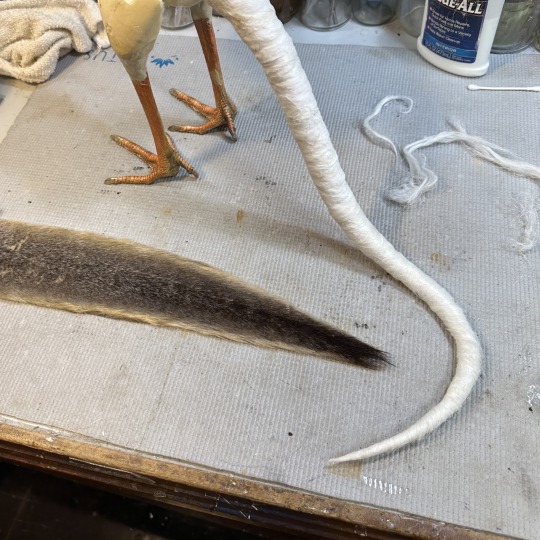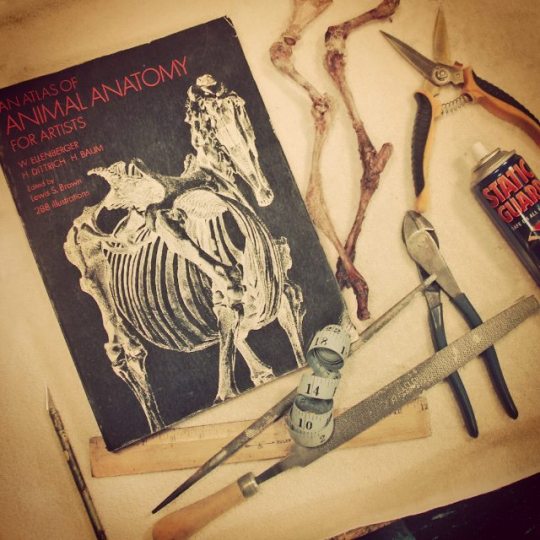#TaxidermyLessons
Text


#TaxidermyTipTuesday ~
I employ, and enjoy, a lot of the old-school taxidermy techniques. Making wrapped wire tails is one of them. If the species you’re working with doesn’t have a fluffy tail that conceals inconsistencies in the diameter of your wrapped tail then it’s a job you can’t rush. Luckily I find the slow repetitive winding of the fibers meditative even though it can sometimes be monotonous as well. Back in the late 1990’s when I was learning taxidermy I bought my tail wrapping fiber from VanDyke's Taxidermy Supplies and they called it “jeweler’s tow” in their catalog. I don’t hear it called that anymore but I think it was simply combed jute or hemp(?) But that’s neither here nor there because my go-to these days is combed flax tow. I think it sticks to itself better and is easier to control than spun hemp or jute. The first layer inside a big thick tail like this one is cotton batting. Then I wrap the flax over the cotton. In many situations I find it beneficial to draw a midline onto the finished wrapped tail so I stay on track as I sew the hide onto it. (Make sure to use a marker that isn’t water water-soluble or it will bleed and could stain your fur) As mentioned, wrapping a tail is an old-school taxidermy technique. These days, for most larger species, you can buy flexible prefab molded urethane tails with a wire center. I still prefer to wrap my own tails because I find it easier to remove excess fiber from a wrapped tail versus shaving down a prefab tail if I find the skin is fitting too tightly once I’m in the process of sewing the skin over my tail. Just a personal preference. I know a lot of people prefer prefab because of the time they can save, but to each their own.
6 notes
·
View notes
Photo

This is the very first book on taxidermy I ever bought. It was sold to me by a taxidermist in Salisbury who thought me how to mount a Jay bird. It was a brilliant introduction to the art of taxidermy and one I shall treasure forever. I still have this book and still go to it whenever I need to. #taxidermylife #taxidermy #taxidermist #book #taxidermybook #taxidermymanual #taxidermyartist #preservedanimals #jay #jaybird #birdtaxidermy #salisbury #wiltshire #cottagetaxidermy #blog #blogger #influencer #stuffedanimal #mountedanimals #nature #wildlife #taxidermylessons #taxidermyforsale #taxidermyforbeginners #instructions #manual #salisburywiltshire #bristoltaxidermy #taxidermybristol #taxidermistsofinstagram (at Chipping Sodbury, South Gloucestershire) https://www.instagram.com/p/BwvGXPShln2/?utm_source=ig_tumblr_share&igshid=ta4ynrtjz0xt
#taxidermylife#taxidermy#taxidermist#book#taxidermybook#taxidermymanual#taxidermyartist#preservedanimals#jay#jaybird#birdtaxidermy#salisbury#wiltshire#cottagetaxidermy#blog#blogger#influencer#stuffedanimal#mountedanimals#nature#wildlife#taxidermylessons#taxidermyforsale#taxidermyforbeginners#instructions#manual#salisburywiltshire#bristoltaxidermy#taxidermybristol#taxidermistsofinstagram
0 notes
Photo

Please reblog if you're interested!
16 notes
·
View notes
Photo

TODAY'S TAXI-TIPS ~
These are a few of the most important things required when I begin working on a urethane foam taxidermy mannequin. The Static Guard spares me a lot of headache as I rasp and sand the urethane foam. It helps keep my tools, clothing, hands, and the mannequin as dust-free as possible while I work. In addition to measuring and tracing an animal's carcass to create my armatures, I also save the legs in most situations. The bones are defleshed but still held together by tiny amounts of residual tissue. Retaining them is useful in two scenarios; They can be used as a visual reference while sanding urethane foam legs to insure the correct shape is achieved. Alternately, I will sometimes use the bones in the construction of my armature rather than shaping urethane foam legs. In this latter "old-school" method the leg bones get completely cleaned, lashed onto the wire armature, then the wire and bone are tightly wrapped to one another with twine and flax roving until the correct leg shape is achieved. Also pictured is my go-to reference book; "An Atlas of Animal Anatomy for Artists" by Wilhelm Ellenberger. This is thee most important book I own. It's a must-have item for anyone sculpting an animal. It contains diagrams of skeletons and musculature, as well as detail drawings of feet, head, eyes, legs, and joints. Regardless of which method you use to create a taxidermy armature, an understanding of an animal's skeletal structure is absolutely essential.
#taxidermyworkshop#taxidermy#taxidermyinstructor#taxidermylesson#taxidermyart#taxidermist#roguetaxidermy#taxidermyprocess#learntaxidermy#taxidermyteacher#taxidermylessons#taxidermysupplies#diytaxidermy#taxidermyclass#femaletaxidermist#taxidermyclasses#taxidermysculpture#taxidermyinstruction
9 notes
·
View notes
Photo

Taxi Tip Tuesday ~
IF YOU OWN ANY TAXIDERMY, READ THIS
Although this is a mundane post, it is an extremely important one if you own taxidermy. Spring has sprung and insects are actively searching for food sources and places to reproduce. All taxidermy mounts are susceptible to insect damage no matter how good the taxidermy job was. Fur and feathers are targeted by the same moths that destroy wool sweaters, and a variety of beetles seek out residual flesh on the underside of animal hides. Freeze-dried taxidermy mounts are exceptionally vulnerable because all muscle tissue is still inside of the mount. Just as precautions need to be taken with the storage of wool garments, taxidermy mounts also need to be cared for. Pictured is a No-Pest Strip. I keep one in the room that houses the bulk of my taxidermy collection year round. I replace the strip twice a year and always make sure to install a fresh one first thing in the spring. You can remove the yellow strip from the white plastic casing and cut it into small chunks. These chunks can be discreetly placed inside display cases, which is what I do to protect my animal mummy collection. Residue from the stick can damage surfaces it comes into contact with, so I put the chunks in a small plastic container with holes drilled in it. I use the tiny clear containers that restaurants put sauce into when I get carry-out (as pictured here) In addition to utilizing a No-Pest Strip, once a year I mist my freeze-dried mounts with a product called Protex Mount Care. (You can also use a cedar oil tincture, which is a natural way to repel insects) Taking preemptive action is key because once you have an infestation it can be difficult to completely eradicate. Your collection will also have a higher chance of becoming reinfested in the future for that reason. Bugs in taxidermy will also eventually find their way into your clothing (and vice versa.) This can happen to anyone, so always better safe than Sorry.
~ Please share this post with other taxidermy enthusiasts.
#taxidermylesson#taxidermytiptuesday#naturalhistorycollection#taxidermyinstruction#taxidermytips#taxidermytip#taxitiptues#vultureculture#taxidermy
14 notes
·
View notes